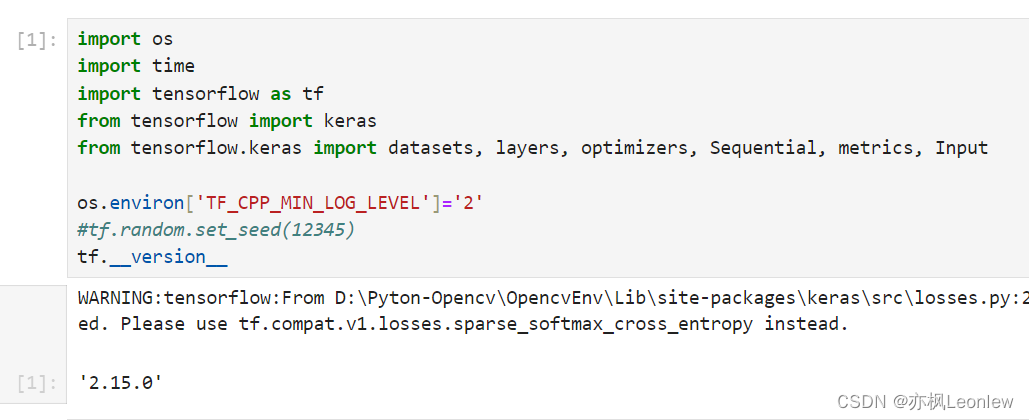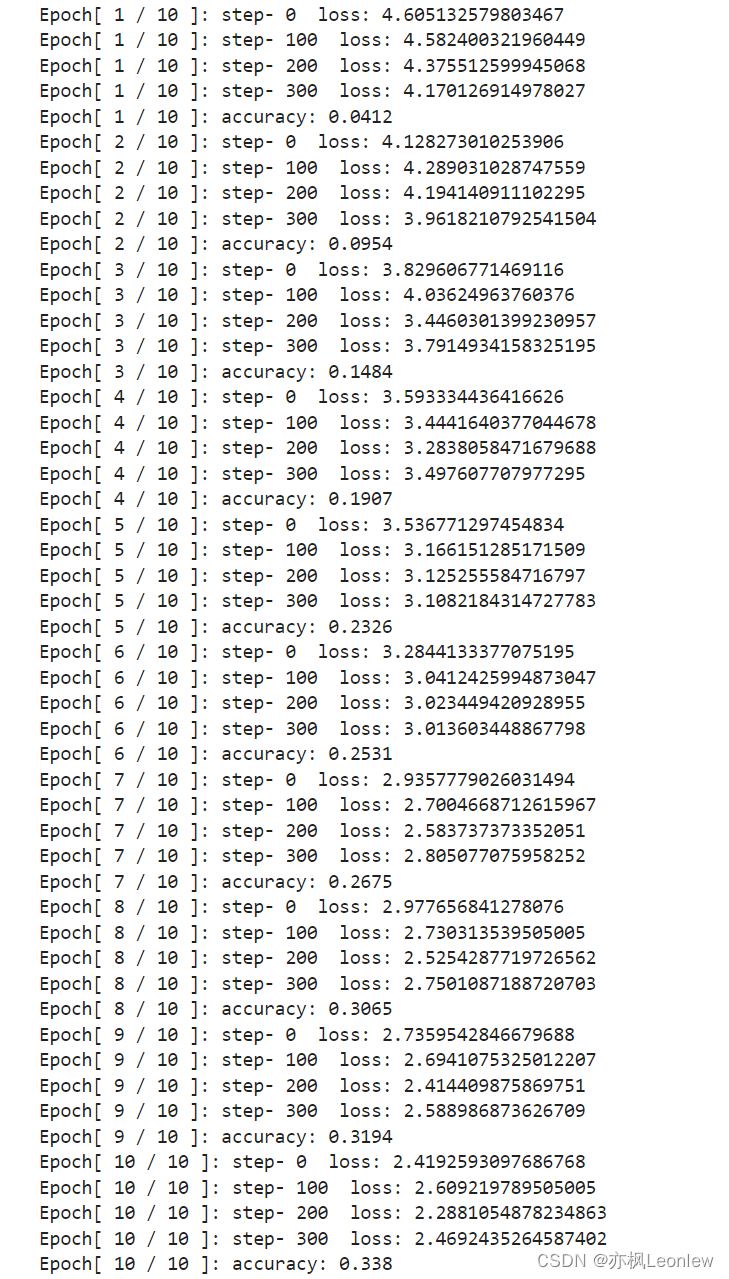本笔记记录CNN做CIFAR100数据集的训练相关内容,代码中使用了类似VGG13的网络结构,做了两个Sequetial(CNN和全连接层),没有用Flatten层而是用reshape操作做CNN和全连接层的中转操作。由于网络层次较深,参数量相比之前的网络多了不少,因此只做了10次epoch(RTX4090),没有继续跑了,最终准确率大概在33.8%左右。
import os
import time
import tensorflow as tf
from tensorflow import keras
from tensorflow.keras import datasets, layers, optimizers, Sequential, metrics, Input
os.environ['TF_CPP_MIN_LOG_LEVEL']='2'
#tf.random.set_seed(12345)
tf.__version__
#如果下载很慢,可以使用迅雷下载到本地,迅雷的链接也可以直接用官网URL:
# https://www.cs.toronto.edu/~kriz/cifar-100-python.tar.gz
#下载好后,将cifar-100.python.tar.gz放到 .keras\datasets 目录下(我的环境是C:\Users\Administrator\.keras\datasets)
# 参考:https://blog.csdn.net/zy_like_study/article/details/104219259
(x_train,y_train), (x_test, y_test) = datasets.cifar100.load_data()
print("Train data shape:", x_train.shape)
print("Train label shape:", y_train.shape)
print("Test data shape:", x_test.shape)
print("Test label shape:", y_test.shape)
def preprocess(x, y):
x = tf.cast(x, dtype=tf.float32) / 255.
y = tf.cast(y, dtype=tf.int32)
return x,y
y_train = tf.squeeze(y_train, axis=1)
y_test = tf.squeeze(y_test, axis=1)
batch_size = 128
train_db = tf.data.Dataset.from_tensor_slices((x_train, y_train))
train_db = train_db.shuffle(1000).map(preprocess).batch(batch_size)
test_db = tf.data.Dataset.from_tensor_slices((x_test, y_test))
test_db = test_db.map(preprocess).batch(batch_size)
sample = next(iter(train_db))
print("Train data sample:", sample[0].shape, sample[1].shape,
tf.reduce_min(sample[0]), tf.reduce_max(sample[0]))
#创建CNN网络,总共4个unit,每个unit主要是两个卷积层和Max Pooling池化层
cnn_layers = [
#unit 1
layers.Conv2D(64, kernel_size=[3,3], padding='same', activation='relu'),
layers.Conv2D(64, kernel_size=[3,3], padding='same', activation='relu'),
#layers.MaxPool2D(pool_size=[2,2], strides=2, padding='same'),
layers.MaxPool2D(pool_size=[2,2], strides=2),
#unit 2
layers.Conv2D(128, kernel_size=[3,3], padding='same', activation='relu'),
layers.Conv2D(128, kernel_size=[3,3], padding='same', activation='relu'),
#layers.MaxPool2D(pool_size=[2,2], strides=2, padding='same'),
layers.MaxPool2D(pool_size=[2,2], strides=2),
#unit 3
layers.Conv2D(256, kernel_size=[3,3], padding='same', activation='relu'),
layers.Conv2D(256, kernel_size=[3,3], padding='same', activation='relu'),
#layers.MaxPool2D(pool_size=[2,2], strides=2, padding='same'),
layers.MaxPool2D(pool_size=[2,2], strides=2),
#unit 4
layers.Conv2D(512, kernel_size=[3,3], padding='same', activation='relu'),
layers.Conv2D(512, kernel_size=[3,3], padding='same', activation='relu'),
#layers.MaxPool2D(pool_size=[2,2], strides=2, padding='same'),
layers.MaxPool2D(pool_size=[2,2], strides=2),
#unit 5
layers.Conv2D(512, kernel_size=[3,3], padding='same', activation='relu'),
layers.Conv2D(512, kernel_size=[3,3], padding='same', activation='relu'),
#layers.MaxPool2D(pool_size=[2,2], strides=2, padding='same'),
layers.MaxPool2D(pool_size=[2,2], strides=2),
]
def main():
#[b, 32, 32, 3] => [b, 1, 1, 512]
cnn_net = Sequential(cnn_layers)
cnn_net.build(input_shape=[None, 32, 32, 3])
#测试一下卷积层的输出
#x = tf.random.normal([4, 32, 32, 3])
#out = cnn_net(x)
#print(out.shape)
#创建全连接层, 输出为100分类
fc_net = Sequential([
layers.Dense(256, activation='relu'),
layers.Dense(128, activation='relu'),
layers.Dense(100, activation=None),
])
fc_net.build(input_shape=[None, 512])
#设置优化器
optimizer = optimizers.Adam(learning_rate=1e-4)
#记录cnn层和全连接层所有可训练参数, 实现的效果类似list拼接,比如
# [1, 2] + [3, 4] => [1, 2, 3, 4]
variables = cnn_net.trainable_variables + fc_net.trainable_variables
#进行训练
num_epoches = 10
for epoch in range(num_epoches):
for step, (x,y) in enumerate(train_db):
with tf.GradientTape() as tape:
#[b, 32, 32, 3] => [b, 1, 1, 512]
out = cnn_net(x)
#flatten打平 => [b, 512]
out = tf.reshape(out, [-1, 512])
#使用全连接层做100分类logits输出
#[b, 512] => [b, 100]
logits = fc_net(out)
#标签做one_hot encoding
y_onehot = tf.one_hot(y, depth=100)
#计算损失
loss = tf.losses.categorical_crossentropy(y_onehot, logits, from_logits=True)
loss = tf.reduce_mean(loss)
#计算梯度
grads = tape.gradient(loss, variables)
#更新参数
optimizer.apply_gradients(zip(grads, variables))
if (step % 100 == 0):
print("Epoch[", epoch + 1, "/", num_epoches, "]: step-", step, " loss:", float(loss))
#进行验证
total_samples = 0
total_correct = 0
for x,y in test_db:
out = cnn_net(x)
out = tf.reshape(out, [-1, 512])
logits = fc_net(out)
prob = tf.nn.softmax(logits, axis=1)
pred = tf.argmax(prob, axis=1)
pred = tf.cast(pred, dtype=tf.int32)
correct = tf.cast(tf.equal(pred, y), dtype=tf.int32)
correct = tf.reduce_sum(correct)
total_samples += x.shape[0]
total_correct += int(correct)
#统计准确率
acc = total_correct / total_samples
print("Epoch[", epoch + 1, "/", num_epoches, "]: accuracy:", acc)
if __name__ == '__main__':
main()运行结果:




